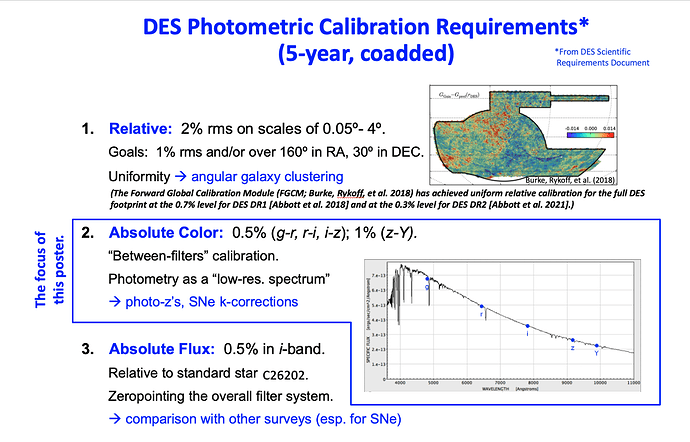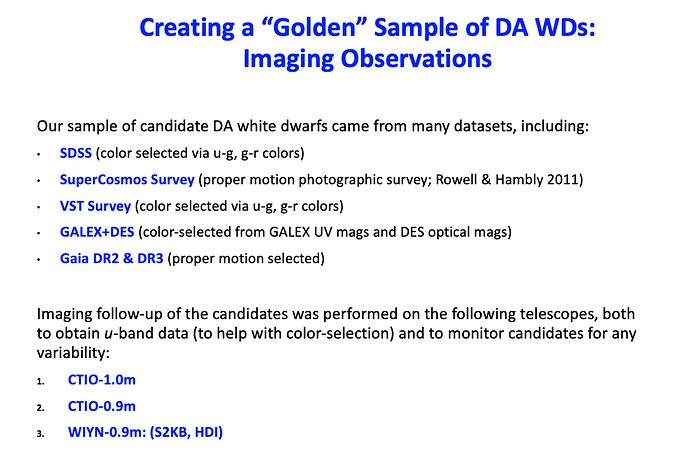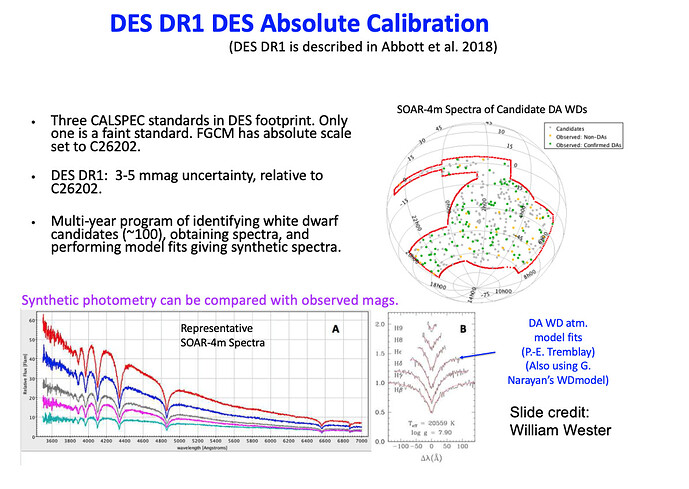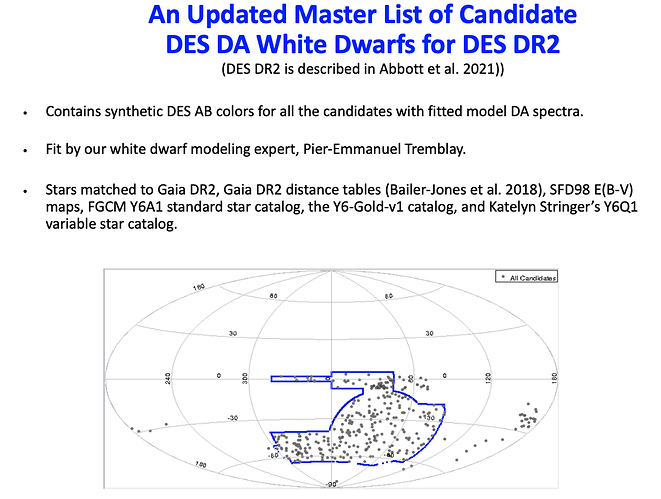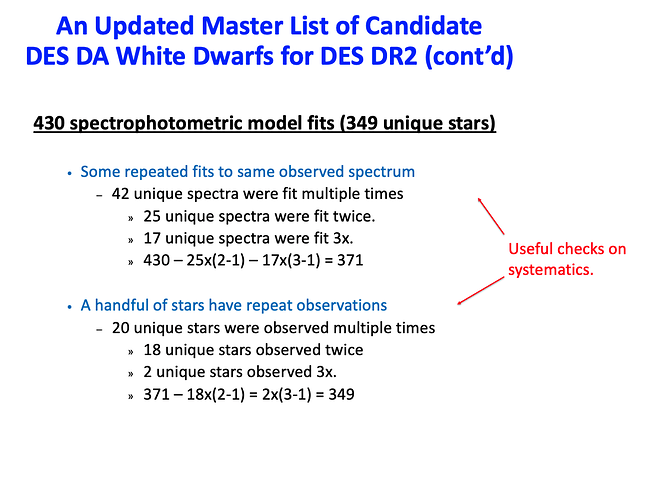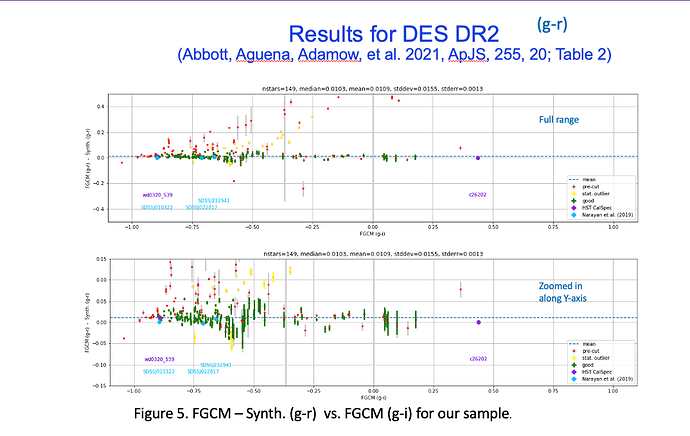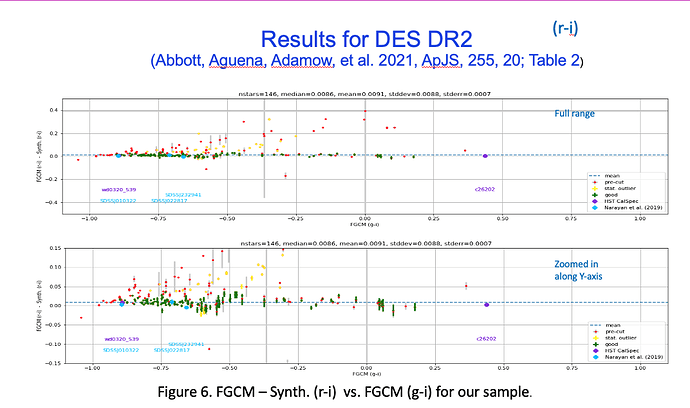Authors: Douglas Tucker (Fermilab), Sahar Allam (Fermilab), J. Allyn Smith (Austin Peay State University), William Wester (Fermilab), Pier-Emmanuel Tremblay (University of Warwick), Sean Peete (Austin Peay State University), Meagan Porter (Austin Peay State University), for the Dark Energy Survey Collaboration.
Abstract: The Dark Energy Survey (DES), which is nearing the completion of the analysis of its full data set, is an imaging survey of one-quarter of the Southern sky down to an apparent magnitude of i~24.5. The survey observations were conducted between 2013 and 2019 with a 3-square-degree wide-field CCD mosaic camera (the Dark Energy Camera, or DECam) on the Blanco 4-meter telescope at the Cerro Tololo Interamerican Observatory in the Chilean Andes. The primary scientific goal of the DES is to measure properties of Dark Energy. In order to achieve its science goals, the DES has tight requirements on both its relative and absolute photometric calibrations. The requirements for the completed survey are (1) an internal uniformity requirement of 2% rms (2) an absolute color (“filter-to-filter”) calibration of 0.5%, and (3) an absolute flux calibration of 0.5% (in i-band relative to a Hubble Space Telescope [HST] CalSpec standard). In this poster, we describe the creation of a “Golden Sample” of ~100 pure-hydrogen-atmosphere (“DA”) white dwarfs that was instrumental in meeting the DES absolute color calibration requirements.
This e-poster is based on an amalgamation of two posters recently presented by Douglas Tucker and J. Allyn Smith at EuroWD24 (the 23rd European Workshop on White Dwarfs).
On Beyond DES…
Remaining work includes finishing the photometry reductions for the smaller telescopes and verifying the data sets agree with the synthetic fits. Then, finish the manuscript(s) which describe it all. Beyond DES, this technique will work well for flux calibrating the Rubin-LSST data, at least some portion of it.
References:
- Abbott, T.M.C., Abdalla, F.B., Allam, S., et al. 2018, “The Dark Energy Survey: Data Release 1,” ApJS, 239, 18
- Abbott, T.M.C., Adamow, M., Aguena, M., et al. 2021, “The Dark Energy Survey Data Release 2,” ApJS, 255, 20
- Burke, D.L., Rykoff, E., Allam, S., et al. 2017, “Forward Global Photometric Caiibration of the Dark Energy Survey,” AJ, 155, 41
Acknowledgments: This project used public archival data from the Dark Energy Survey (DES). Funding for the DES Projects has been provided by the U.S. Department of Energy, the U.S. National Science Foundation, the Ministry of Science and Education of Spain, the Science and Technology Facilities Council of the United Kingdom, the Higher Education Funding Council for England, the National Center for Supercomputing Applications at the University of Illinois at Urbana–Champaign, the Kavli Institute of Cosmological Physics at the University of Chicago, the Center for Cosmology and Astro-Particle Physics at the Ohio State University, the Mitchell Institute for Fundamental Physics and Astronomy at Texas A&M University, Financiadora de Estudos e Projetos, Fundação Carlos Chagas Filho de Amparo à Pesquisa do Estado do Rio de Janeiro, Conselho Nacional de Desenvolvimento Científico e Tecnológico and the Ministério da Ciência, Tecnologia e Inovação, the Deutsche Forschungsgemeinschaft and the Collaborating Institutions in the Dark Energy Survey.
The Collaborating Institutions are Argonne National Laboratory, the University of California at Santa Cruz, the University of Cambridge, Centro de Investigaciones Enérgeticas, Medioambientales y Tecnológicas–Madrid, the University of Chicago, University College London, the DES-Brazil Consortium, the University of Edinburgh, the Eidgenössische Technische Hochschule (ETH) Zürich, Fermi National Accelerator Laboratory, the University of Illinois at Urbana-Champaign, the Institut de Ciències de l’Espai (IEEC/CSIC), the Institut de Física d’Altes Energies, Lawrence Berkeley National Laboratory, the Ludwig-Maximilians Universität München and the associated Excellence Cluster Universe, the University of Michigan, the National Optical Astronomy Observatory, the University of Nottingham, The Ohio State University, the OzDES Membership Consortium, the University of Pennsylvania, the University of Portsmouth, SLAC National Accelerator Laboratory, Stanford University, the University of Sussex, and Texas A&M University.
Based in part on observations at Cerro Tololo Inter-American Observatory, National Optical Astronomy Observatory, which is operated by the Association of Universities for Research in Astronomy (AURA) under a cooperative agreement with the National Science Foundation.
